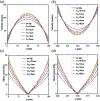Effects of wall velocity slip on droplet generation in microfluidic T-junctions
- PMID: 35514511
- PMCID: PMC9067282
- DOI: 10.1039/c9ra03761f
Effects of wall velocity slip on droplet generation in microfluidic T-junctions
Abstract
The effect of the slip lengths of both continuous and dispersed phases on droplet formation in microfluidic T-junctions is investigated by a volume of fluid method. Results reveal that, in a dripping regime, the droplet size is mainly influenced by the slip length of the continuous phase and increases with it. In a squeezing regime, the droplet size decreases with the slip lengths of both phases. The effects of the slip lengths of both phases on droplet generation are systematically discussed and summarized. The elongation rate of the thread can be decreased with an increase of slip lengths in both dripping and squeezing regimes, which is beneficial to improve droplet monodispersity. The monodispersity of droplets can deteriorate when the slip length of either phase is small and can be improved by increasing the slip length of the other phase.
This journal is © The Royal Society of Chemistry.
Conflict of interest statement
There are no conflicts to declare.
Figures
















Similar articles
-
Dripping, Jetting and Regime Transition of Droplet Formation in a Buoyancy-Assisted Microfluidic Device.Micromachines (Basel). 2020 Oct 27;11(11):962. doi: 10.3390/mi11110962. Micromachines (Basel). 2020. PMID: 33121113 Free PMC article.
-
Effect of the fluid injection configuration on droplet size in a microfluidic T junction.Phys Rev E Stat Nonlin Soft Matter Phys. 2014 Jan;89(1):013003. doi: 10.1103/PhysRevE.89.013003. Epub 2014 Jan 7. Phys Rev E Stat Nonlin Soft Matter Phys. 2014. PMID: 24580316
-
Non-Newtonian Droplet Generation in a Cross-Junction Microfluidic Channel.Polymers (Basel). 2021 Jun 9;13(12):1915. doi: 10.3390/polym13121915. Polymers (Basel). 2021. PMID: 34207574 Free PMC article.
-
Experimental observations of the squeezing-to-dripping transition in T-shaped microfluidic junctions.Phys Rev E Stat Nonlin Soft Matter Phys. 2008 Sep;78(3 Pt 2):036317. doi: 10.1103/PhysRevE.78.036317. Epub 2008 Sep 18. Phys Rev E Stat Nonlin Soft Matter Phys. 2008. PMID: 18851153
-
Microfluidic Droplet-Generation Device with Flexible Walls.Micromachines (Basel). 2023 Sep 15;14(9):1770. doi: 10.3390/mi14091770. Micromachines (Basel). 2023. PMID: 37763933 Free PMC article.
References
LinkOut - more resources
Full Text Sources

